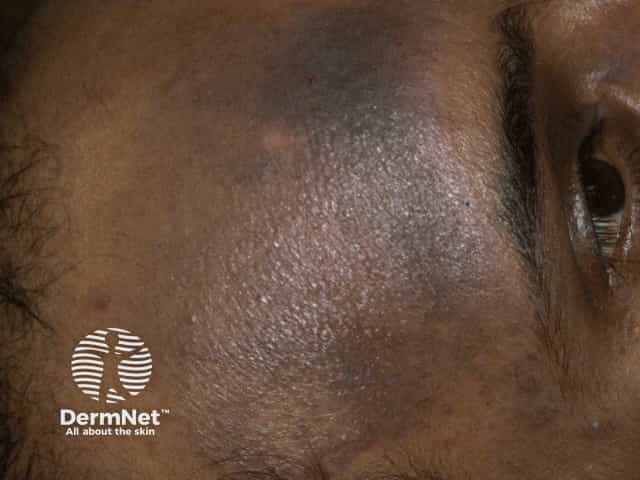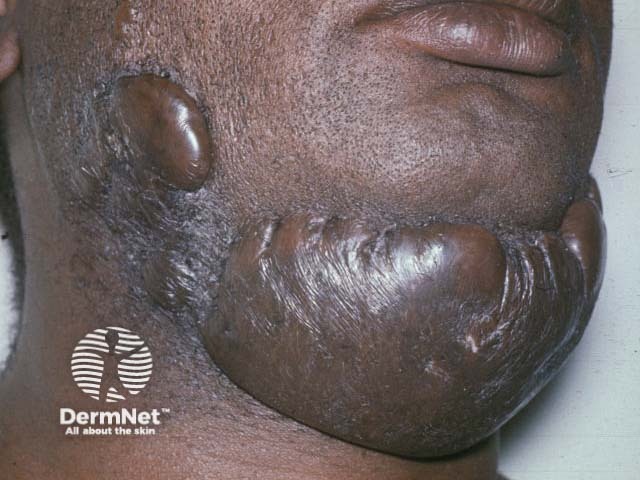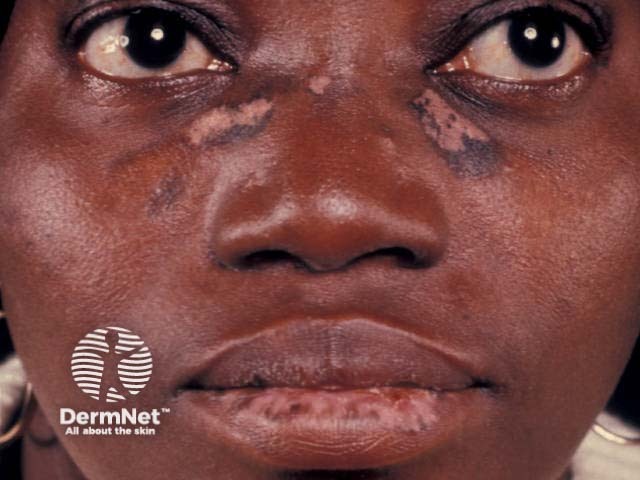Main menu
Common skin conditions

NEWS
Join DermNet PRO
Read more
Quick links
Author: Dr Ramez Barsoum, Resident Medical Officer, Princess Alexandra Hospital, Brisbane, QLD, Australia. DermNet Editor in Chief: Adjunct A/Prof Amanda Oakley, Dermatologist, Hamilton, New Zealand. Copy edited by Gus Mitchell/Maria McGivern. June 2019.
Introduction
Skin in different populations
Indications
Outcome
Skin of colour refers to non-white skin types, with a particular emphasis on Fitzpatrick skin phototypes V and VI. It is characterised by increased epidermal melanin (a brown pigment), more widely distributed melanosomes (the melanin-containing granules within melanocytes), changing melanocyte response, and overactive fibroblasts.

Hyperpigmentation due to atopic eczema

Keloid scar

Discoid lupus erythematosus causing hypopigmentation and hyperpigmentation
Since melanin absorbs and scatters the energy transmitted from ultraviolet radiation (UVR), persons with skin of colour experience less epidermal damage after exposure to UVR and show fewer signs of photoageing than people with lighter skin types [1,2].
Skin of colour almost always develops pigmentary changes when exposed to injury or inflammation (postinflammatory hyperpigmentation and postinflammatory hypopigmentation), whereas pigmentary changes are uncommon in white skin [3].
Melanin can act as a competitive chromophore (a coloured molecule that absorbs transmitted energy), which increases the risk of side effects after epidermal injury by a laser [4].
People with skin of colour have a higher prevalence of hypertrophic scarring and keloids after injury than those with white skin due to genetic factors associated with hyperactive fibroblasts [2,3].
The medical indications for laser therapy are similar whatever the colour of the skin. However, women of colour often seek treatment for hyperpigmentation and uneven skin colour as these are common aesthetic concerns [2].
Laser therapy may also be used to remove dark, coarse, terminal hairs, which may lead to pseudofolliculitis barbae, folliculitis barbae, folliculitis keloidalis nuchae, and folliculitis decalvans — conditions that are more common in skin of colour [5].
The safest laser for hair removal in individuals with skin of colour is the long-pulsed neodymium-doped yttrium aluminium garnet (Nd:YAG) laser.
The use of the alexandrite laser (wavelength of 755 nm) has not been extensively studied in skin of colour. It has been reported to cause blistering in patients with Fitzpatrick skin types V and VI [7].
Use of a diode laser (wavelength 800 nm) has been reported to be mainly safe with low rates of complications, including the occurrence of transient blistering and pigment alteration [8].
Acne scars may be treated with an ablative carbon dioxide laser or erbium-doped yttrium aluminium garnet (Er:YAG) laser, but these are best avoided in skin types V and VI as thermal injury commonly causes postinflammatory hyperpigmentation [9].
Non-ablative Nd:YAG laser has fewer side effects compared to ablative laser resurfacing and produces comparable results.
Few studies on the removal of tattoos in skin of colour have been reported. Charcoal-based blue/black religious tattoos in Ethiopian patients with skin types V and VI have been removed using a Q-switched Nd:YAG [10]. In this study, almost half of the patients developed mild postinflammatory hyperpigmentation lasting between 2 and 4 months.
Removal of tattoos in skin of colour can be difficult and unpredictable because of the epidermal melanin, which absorbs the transmitted energy and prevents it from reaching the ink in the dermis.
Cooling is used to protect the epidermis from thermal burn [11].
Epidermal injury should be monitored carefully in skin of colour.
Patient expectations should be realistic, and they should be informed about the risk of complications and side effects associated with laser therapies [2].